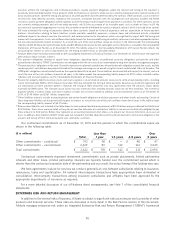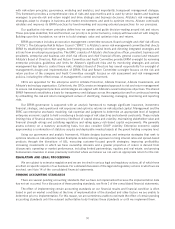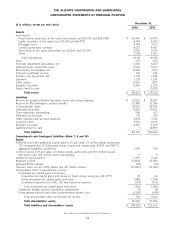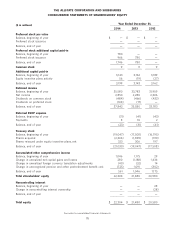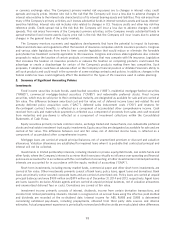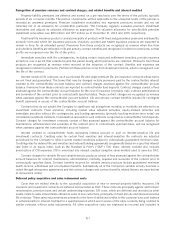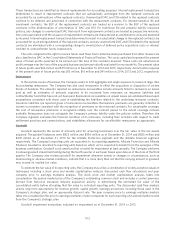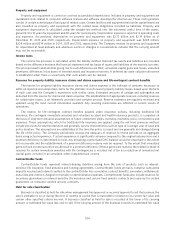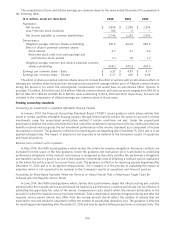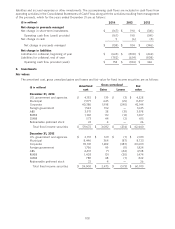Allstate 2014 Annual Report Download - page 198
Download and view the complete annual report
Please find page 198 of the 2014 Allstate annual report below. You can navigate through the pages in the report by either clicking on the pages listed below, or by using the keyword search tool below to find specific information within the annual report.or currency exchange rates. The Company’s primary market risk exposures are to changes in interest rates, credit
spreads and equity prices. Interest rate risk is the risk that the Company will incur a loss due to adverse changes in
interest rates relative to the interest rate characteristics of its interest bearing assets and liabilities. This risk arises from
many of the Company’s primary activities, as it invests substantial funds in interest-sensitive assets and issues interest-
sensitive liabilities. Interest rate risk includes risks related to changes in U.S. Treasury yields and other key risk-free
reference yields. Credit spread risk is the risk that the Company will incur a loss due to adverse changes in credit
spreads. This risk arises from many of the Company’s primary activities, as the Company invests substantial funds in
spread-sensitive fixed income assets. Equity price risk is the risk that the Company will incur losses due to adverse
changes in the general levels of the equity markets.
The Company monitors economic and regulatory developments that have the potential to impact its business.
Federal and state laws and regulations affect the taxation of insurance companies and life insurance products. Congress
and various state legislatures from time to time consider legislation that would reduce or eliminate the favorable
policyholder tax treatment currently applicable to life insurance. Congress and various state legislatures also consider
proposals to reduce the taxation of certain products or investments that may compete with life insurance. Legislation
that increases the taxation on insurance products or reduces the taxation on competing products could lessen the
advantage or create a disadvantage for certain of the Company’s products making them less competitive. Such
proposals, if adopted, could have an adverse effect on the Company’s financial position or Allstate Financial’s ability to
sell such products and could result in the surrender of some existing contracts and policies. In addition, changes in the
federal estate tax laws could negatively affect the demand for the types of life insurance used in estate planning.
2. Summary of Significant Accounting Policies
Investments
Fixed income securities include bonds, asset-backed securities (‘‘ABS’’), residential mortgage-backed securities
(‘‘RMBS’’), commercial mortgage-backed securities (‘‘CMBS’’) and redeemable preferred stocks. Fixed income
securities, which may be sold prior to their contractual maturity, are designated as available for sale and are carried at
fair value. The difference between amortized cost and fair value, net of deferred income taxes and related life and
annuity deferred policy acquisition costs (‘‘DAC’’), deferred sales inducement costs (‘‘DSI’’) and reserves for
life-contingent contract benefits, is reflected as a component of accumulated other comprehensive income. Cash
received from calls and make-whole payments is reflected as a component of proceeds from sales and cash received
from maturities and pay-downs is reflected as a component of investment collections within the Consolidated
Statements of Cash Flows.
Equity securities primarily include common stocks, exchange traded and mutual funds, non-redeemable preferred
stocks and real estate investment trust equity investments. Equity securities are designated as available for sale and are
carried at fair value. The difference between cost and fair value, net of deferred income taxes, is reflected as a
component of accumulated other comprehensive income.
Mortgage loans are carried at unpaid principal balances, net of unamortized premium or discount and valuation
allowances. Valuation allowances are established for impaired loans when it is probable that contractual principal and
interest will not be collected.
Investments in limited partnership interests, including interests in private equity/debt funds, real estate funds and
other funds, where the Company’s interest is so minor that it exercises virtually no influence over operating and financial
policies are accounted for in accordance with the cost method of accounting; all other investments in limited partnership
interests are accounted for in accordance with the equity method of accounting (‘‘EMA’’).
Short-term investments, including money market funds, commercial paper and other short-term investments, are
carried at fair value. Other investments primarily consist of bank loans, policy loans, agent loans and derivatives. Bank
loans are primarily senior secured corporate loans and are carried at amortized cost. Policy loans are carried at unpaid
principal balances and were $909 million and $919 million as of December 31, 2014 and 2013, respectively. Agent loans
are loans issued to exclusive Allstate agents and are carried at unpaid principal balances, net of valuation allowances
and unamortized deferred fees or costs. Derivatives are carried at fair value.
Investment income primarily consists of interest, dividends, income from certain derivative transactions, and
income from limited partnership interests. Interest is recognized on an accrual basis using the effective yield method
and dividends are recorded at the ex-dividend date. Interest income for ABS, RMBS and CMBS is determined
considering estimated pay-downs, including prepayments, obtained from third party data sources and internal
estimates. Actual prepayment experience is periodically reviewed and effective yields are recalculated when differences
98




